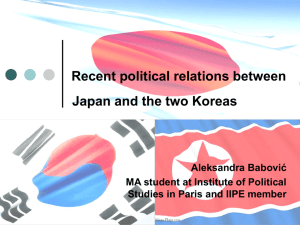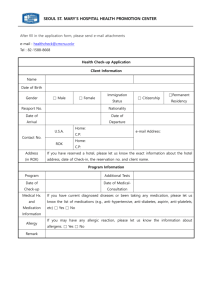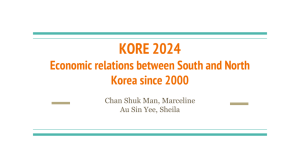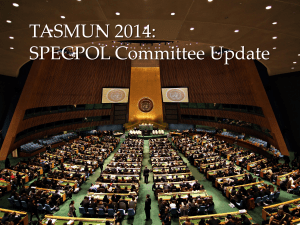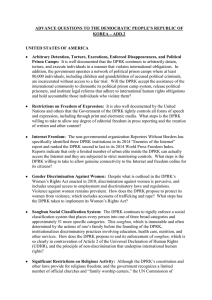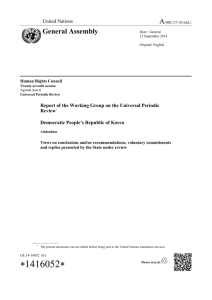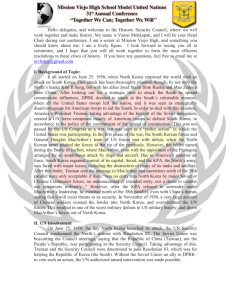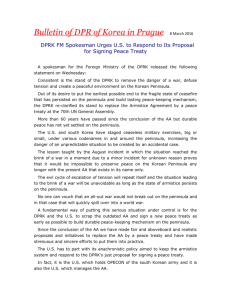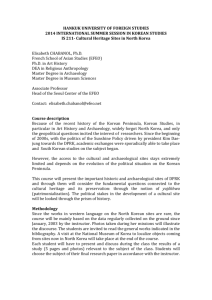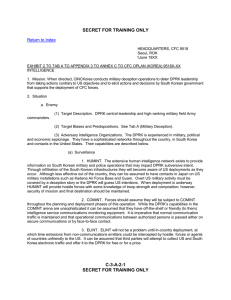1. Basic determinants: RoK
advertisement
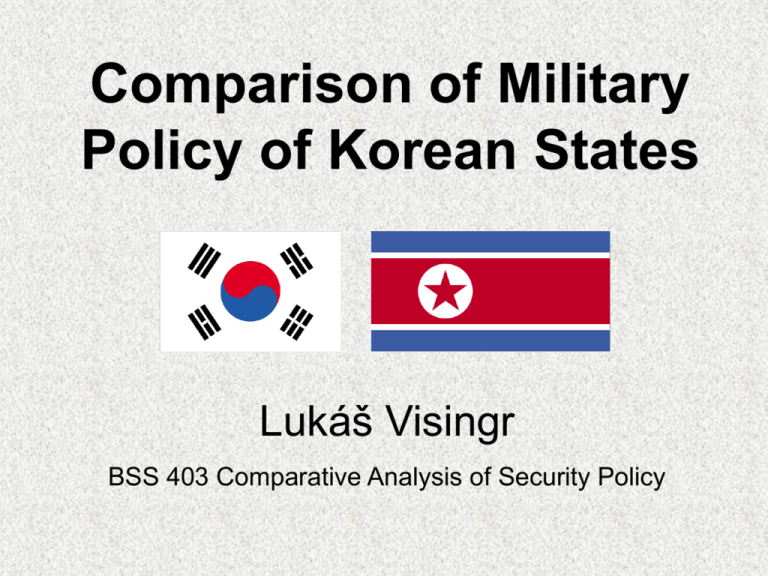
Comparison of Military Policy of Korean States Lukáš Visingr BSS 403 Comparative Analysis of Security Policy Contents 1. Basic determinants 2. Armed forces 3. Strategy and tactics 4. Armament policy 5. Missiles and WMDs 6. Conclusions South: Republic of Korea (RoK) North: Democratic People’s Republic of Korea (DPRK) 1. Basic determinants: Common • Specific geographic conditions of the Korean Peninsula (mountains, broken coast) • Divided nation with (probably) sincere desire of reunification, but with different views of the nature and costs of the process • The Demilitarized Zone on the 38th parallel • Suspicious reception of Japan 1. Basic determinants: RoK • Political system: former authoritative military régime, now liberal democracy • Economy: market capitalism, very steady material basis of armament policy • Democratic control of armed forces more or less works, but not yet perfectly • Ally of the USA, 36 000 US soldiers (CFC), but controversial receptions • North Koreans viewed not as „enemies“, but as „victims“ of a horrible régime 1. Basic determinants: DPRK • Lack of data, even the basic intentions are uncertain, the régime is unpredictable • Political system: ruthless communist totality, the most isolated country in the world, with apparently psychopathic leader • Economy: completely disastrous situation, insufficient supplies • Army under control of the Party, although a „military opposition“ could exist • Strong (but limited) influence of China 2. Armed forces: RoK • Republic of Korea Armed Forces • Built along the American model • High-quality soldiers with excellent training, surpassing average Western level • Branches: Army, Navy (including the Marine Corps), Air Force and Reserve Forces • Paramilitary forces: Civil Defense Corps and Maritime Police 2. Armed forces: DPRK • Korean People’s Army • Built along the Soviet and Chinese models • Numerical superiority and (possibly) strong morale, but desperate quality (maybe with the exception of Special Forces) • Branches: Ground Forces, Navy, Air Force and Artillery Guidance Bureau (missiles) • Paramilitary forces: Security Troops and Worker-Peasant Red Guard • Specialty: underground bases and factories 3. Strategy and tactics: RoK • Basic goal: defense against DPRK attack and subsequent liberation (?) • US Air-Land Battle model, modified for the local geographic conditions • Clear tendencies to adopt the „information warfare“ and „network“ concepts • Counting on hi-tech weapons, joint actions, precise cooperation, air superiority, elastic defense, C4ISTAR, mobile support • The question of preemptive strikes 3. Strategy and tactics: DPRK • Basic goal: surprising attack against the RoK, before the USA could respond • Soviet „in-depth operation“ and Chinese „people’s war“ models, modified for the local geographic conditions • Devastating artillery preparation, rapid break-through of tank and mechanized units, massive utilization of airborne and diversion forces • Probably terrorist attacks and WMDs 4. Armament policy: RoK • Formerly dependent on US weapons, now becoming more self-sufficient • Daewoo, Hyundai, Samsung, KAI… • RoK produces hi-tech weapons, sometimes overmatching the American types • K2 tank, K9 howitzer, T-50 training airplane, Sejong destroyer… • Arms export: RoK becomes an important supplier, the largest customer is Turkey 4. Armament policy: DPRK • Formerly dependent on Soviet and Chinese weapons, now partially self-sufficient • Producing many copies and modifications and certain original types • Most of the weapons are obsolete „scrap“, but definitely not all of them: Pokpoong-ho tank, Koksan howitzer, stealth boats… • Arms export: DPRK supplies „rogue states“ such as Iran or Syria 5. Missiles and WMDs • DPRK has arsenal of hundreds of SRBMs and MRBMs and technology for producing ICBMs (unsuccessful tests) • DPRK probably possesses huge stockpiles of chemical and biological weapons • DPRK has produced nuclear warheads, but probably not suitable for missiles • RoK possesses a small number of ballistic missiles, but no WMDs (although the state is technologically nuclear-capable) 6. Conclusions • Some common features, such as adaptations on specific geographic conditions or efforts to be self-sufficient in armament policy • However, the RoK and DPRK could serve as perfect examples of two completely different types of military policy • Two very similar states (even with the same nation) controlled by antipodal régimes could pursue fully opposite military policies Main sources • Hodge, H. T.: North Korea’s Military Strategy, on-line text (http://www.carlisle.army.mil/usawc/Parameters/03spring/hodge.htm). • Korean Peoples’ Army, WWW site (http://www.globalsecurity.org/military/world/dprk/army.htm). • Langton, Ch. (ed.): The Military Balance 2007, London: Routledge 2007. • Miller, D. - Foss, Ch. F.: Moderní pozemní boj, Praha: Naše vojsko 2004. • Republic of Korea Ministry of National Defense, WWW site (http://www.mnd.mil.kr/). • Republic of Korea Military Guide, WWW site (http://www.globalsecurity.org/military/world/rok/index.html).
